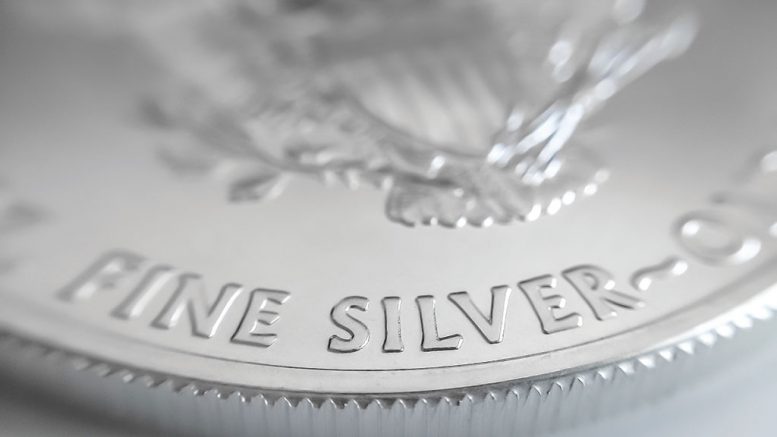The GFMS team at Refinitiv recently published its latest findings on the global silver market, highlighting the shift in supply and demand over the course of 2019 and provided provisional supply and demand estimates for 2020. The market faced some significant challenges last year, but 2020 is shaping up to be one of the toughest in a generation. Forecast numbers, finalized in early March, may now need to be recalibrated as we come to terms with the reality of COVID-19 and the true impact it will have on the global economy.
Total physical demand was down by 2% last year to 1,035.1 million oz. driven lower by a drop in silver used in industrial applications and jewellery, although this was slightly offset by a pick-up in retail investment which benefited from the global uncertainty with both bars and coin demand recording solid gains.
Looking to supply, mine production declined by less than 1% to an estimated 853.7 million oz., with losses in South America and Oceania being slightly offset by higher output in Europe and North America. Silver mine production is forecast to drop by at least 2% to 835 million oz. this year, with mining companies all around the world now starting to take precautionary measures and scaling down their operations in light of the global pandemic. Scrap supply rose to a five-year high of 160.3 million oz., up by 6% from the previous year, with higher prices stimulating scrap flows across the major markets.
Industrial demand accounts for over 55% of total demand in any year, and in 2019 it declined by 4% to 555 million ounces. The fall, the second in succession, saw demand in this key sector fall to levels not seen since the global financial crisis as the ongoing trade wars between the United States and China dragged the global economy lower. The outlook in this sector remains bleak, with industry hit hard by the rapid spread of COVID-19 that has brought several manufacturing centres to their knees.
The largest decline in volume terms last year was recorded by the electronics and other industrial segments, where demand for silver slipped by 8.6 million oz. and 5.3 million oz., respectively. Meanwhile, demand from the photovoltaic (PV) sector, the darling of the industry in recent years, recorded its second consecutive fall in 2019, dipping by 3% to 74.2 million oz., owing largely to the ongoing thrifting of silver in PV modules, even as global photovoltaic installations continue to rise.
Demand from the jewellery sector slipped by 1% to 210 million oz., driven by lower offtake in Asia, particularly in China, where jewellery fabrication tumbled by 11% to the lowest level since 2003. While structural factors and a shift in consumer preferences had been weighing on the domestic market, the economic slowdown and trade tensions put a major drag on jewellery demand last year. Meanwhile, Indian demand rose slightly to a record high level, driven by strong demand in the first half of the year thanks to increased wedding days and a lower silver price.
North American fabrication remained on the winners list, if only just at less than 1% annual growth. The U.S., which accounts for over 75% of this grouping, recorded its seventh consecutive increase in fabrication to a record high, but at just 1% was the lowest level of expansion over this entire period. The outlook in this sector in 2020 is also very concerning. We are already aware of layoffs in this industry, especially in the western markets, as government-mandated shutdowns have shuttered many department stores and retail outlets, severely impacting fabrication demand.
Having benefitted from the rise in economic uncertainty last year, we expect investment demand in silver to record another year of solid growth, with positive inflows into silver exchange-traded products (ETPs) anticipated again this year. Demand for bars and coins is forecast to surge by 24%, partly driven by a buying frenzy across all the major markets in the first quarter as the silver price plunged to its lowest in more than ten years, as well as a renewed investor interest in safe havens later in the year once global financial markets stabilize.
The silver price averaged US$16.21 per oz. in 2019, up by 3% from the previous year. The performance for most of the first half was rather disappointing, with the dollar price losing 6% in the first five months, plunging below the US$15 per oz. level in April. By contrast, the second half of the year saw the silver price soar by 18%, breaking through the US$19 per oz. mark in early September for the first time in nearly three years.
After rising to a five-month high by late February this year, the silver price experienced a calamitous fall in March, as precious metals got caught up in a broader market sell-off amidst the deteriorating virus outbreak. As a result, silver lost 30% of its dollar value in the first three weeks of the month, trading at around the US$12 per oz. level, the lowest in more than ten years. Looking ahead, we expect prices to recover from current lows, driven by bargain hunting, before moving higher later in the year once the market hysteria calms down and safe-haven demand kicks in, taking the silver price to an annual average of US$15.55 per oz. this year, down by 4% year-on-year.
— Cameron Alexander is manager of the precious metals research team at Refinitiv. Refinitiv is a global financial market data firm founded in 2018 by Blackstone Group (55%) and Thomson Reuters (45%).


Be the first to comment on "Commentary: Silver to struggle in 2020 due to COVID-19"